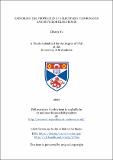Files in this item
Exploring the properties of selectively fluorinated Janus cyclohexane rings
Item metadata
| dc.contributor.advisor | O'Hagan, David | |
| dc.contributor.author | Yu, Cihang | |
| dc.coverage.spatial | 383 | en_US |
| dc.date.accessioned | 2023-05-11T11:26:49Z | |
| dc.date.available | 2023-05-11T11:26:49Z | |
| dc.date.issued | 2023-06-14 | |
| dc.identifier.uri | https://hdl.handle.net/10023/27569 | |
| dc.description.abstract | Janus face fluorocycloalkanes (JFC) represent a novel subject of study. The fluorinated electronegative face and the hydrogenated electropositive face of the rings create an extraordinarily high dipole moment which induces facial polarity. This thesis carries out various studies on this new class of compound. In Chapter 1, a discussion of the background and general interest in fluorine chemistry is given. The role of fluorine in pharmaceutical chemistry is demonstrated. The most recent studies on the JFC are summarised and discussed, including their preparation and applications in ionic binding, supramolecular chemistry, and biological chemistry. In Chapter 2, a recently reported stereoselective Rh-catalysed hydrogenation was further explored, and its substrate scope was extended to aryl–CF₃ to deliver facially polarised CF₃–cyclohexane motifs in high diastereoselectivity. The direct preparation of CF₃–containing cyclohexanes form a library of stereoselective motifs for further studies. In Chapter 3, the study of facially polar CF₃–cyclohexane was extended to the preparation, properties and physiochemistry of all-cis-multi-CF₃ cyclohexanes with between 3 and 6 substituent CF₃ groups. The prepared all-cis-hexakis-CF₃–cyclohexane has a high barrier to ring inversion (27 kcal mol⁻¹), more than twice that of cyclohexane. This ring also coordinates chloride (Cl-) ion to the hydrogen face with a modest affinity constant (K = 10³ M⁻¹). In Chapter 4, the surface behaviour of the all-cis-hexafluorocyclohexane was studied on HOPG and gold surfaces. The reactivity of JFCs was studied, and a number of functional groups were installed onto the ring. of A novel amino acid of with a JFC side chain was prepared and incorporated into peptide synthesis. In Chapter 5, trifluoro substituted cyclohexanes were prepared. An unexpected triaxial preference was found in all-cis-1,3,5-trifluorocyclohexane and some of its derivatives. The conformational preferences of these derivatives were also investigated. In Chapter 6, the JFC motifs were transformed into multi-dentate supramolecular architectures. The proposed frameworks were synthesized in modular approaches. The crystal structure of a number of the building blocks were demonstrated with voids in their supramolecular architectures. | en_US |
| dc.description.sponsorship | “I gratefully acknowledge the funding body China Scholarship Council (CSC) for PhD studentship. No. 201703780007”—Acknowledgements | en |
| dc.language.iso | en | en_US |
| dc.relation | Exploring the Properties of Selectively Fluorinated Janus Cyclohexane Rings (thesis data) Yu, C., University of St Andrews, 9 May 2023. DOI: https://doi.org/10.17630/7310cff9-f312-4bcf-81c5-000ef10205e1 | en |
| dc.relation.uri | https://doi.org/10.17630/7310cff9-f312-4bcf-81c5-000ef10205e1 | |
| dc.subject | Organic chemistry | en_US |
| dc.subject | Fluorine chemistry | en_US |
| dc.subject | Organofluorine chemistry | en_US |
| dc.subject | Janus faced compounds | en_US |
| dc.title | Exploring the properties of selectively fluorinated Janus cyclohexane rings | en_US |
| dc.type | Thesis | en_US |
| dc.contributor.sponsor | China Scholarship Council (CSC) | en_US |
| dc.type.qualificationlevel | Doctoral | en_US |
| dc.type.qualificationname | PhD Doctor of Philosophy | en_US |
| dc.publisher.institution | The University of St Andrews | en_US |
| dc.identifier.doi | https://doi.org/10.17630/sta/440 | |
| dc.identifier.grantnumber | 201703780007 | en_US |
This item appears in the following Collection(s)
Items in the St Andrews Research Repository are protected by copyright, with all rights reserved, unless otherwise indicated.

